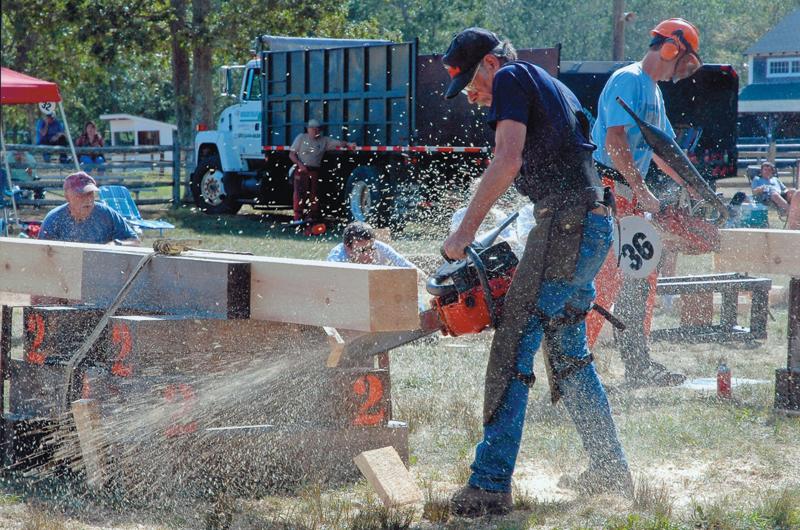
Walter Ashley is lean and straight as a cedar as he sits in an office wallpapered with ribbons from the Woodsmen’s Contest at the Martha’s Vineyard Agricultural Society’s Livestock Show and Fair. The annual competition features a variety of events, including Log Rolling, Axe Throwing, Wood Splitting, and Buck Sawing, but Walter’s favorite is the one you can hear while you’re still in the parking lot: Chainsaw Cutting.
Walter, who lives in Oak Bluffs and owns C& W Power Equipment in Edgartown, says he originally got involved with the event back in the eighties by souping up saws for other competitors. But as he puts it, “I got sick of doing all that work and having guys screw up, so around twenty-five years ago, I decided to get in there and try it myself.”
Chain saw cutting is a lot like NASCAR racing: To win, you not only need skill and technique, you also have to have a hot machine – a saw may look like the one you have in your shed, but then a Daytona stock car looks sort of like something that could be parked in your driveway.
There are three classes of saws at the Ag Fair competition. The first is the 4.5 Cubic Inch and Under Class; you might actually mistake these for something you would own. The next class up is the Open Stock Class, in which there’s no limit to the size of the engine so long as the saw resembles the original factory design (typically the engines range up to 140 cubic inches). And then there’s the Modified Class; these are the funny cars of chain saws and you might want to bring earplugs.
As with NASCAR racers, the term “stock” is used loosely. As Walter explains, “Usually about the only thing that hasn’t been modified is the rear handle.” Engine ports are enlarged, mufflers are tuned, chains are reconfigured, and sprockets and bars are maxed out. Even the front handle is bent to provide just the right balance for the individual cutter.
In the old days, guys like Walter would do all this work themselves, relying on trial and error and experience to maximize performance. But in recent years, the sport has become more and more sophisticated and many competitors now buy performance-enhanced machines that have been configured to exacting standards with computers. But this level of performance doesn’t come without a price; a good modified saw can cost upwards of $4,500.
Ironically this enhanced performance can sometimes be more of a curse than a blessing; the saws can become too powerful to handle. Walter says, “With the big saws, you really have to brace yourself. Cutting downwards is no problem, but on the up cut the saw wants to push everything toward you and it can actually throw you backwards. It takes practice.”
And then there’s the fuel. Today these hot-rod saws pretty much all run on methanol mixtures, and there’s a real art to finding just the right blend. Walter explains there are a few guys around the country who make up the mixtures, and they’re fussy about who they sell to. If they like you, you can buy some from them; if they don’t, you just have to go somewhere else. And if you think gas is expensive on the Island, these premium methanol blends can go for around forty-five dollars a gallon.
So how fast are these saws? The Horizontal Cutting event requires the contestant to start with both hands on the log and the saw turned off. At “Go!” the cutter must start the saw and make three cuts – one down, one up, and one down – through an eight-inch-by-eight-inch white pine timber. If you can’t make those cuts in a little more than three seconds, you probably won’t even qualify.
But it’s not just about speed – there are two other chain saw events and they both require a great deal of finesse. In the Disk Stacking event, contestants have to cut a series of disks from a vertical log. The trick is the disks have to remain stacked on top of one another, and it’s not unusual for a contestant to stack in excess of twenty disks. The contestant who has the most stacked disks in the allotted time is the winner.
The Chainsaw Sculpture competition, which is open only to Vineyarders, is all about finesse. There’s no demand for speed at all, other than you have to deliver your work of art to the judges by 11 a.m. on the day of the contest, which is traditionally Saturday. There’s also no limit to size so long as the sculpture is made of one piece of wood and entirely sculpted by a chain saw.
Given the skill set required to compete in these events, you might think there would be a big reward for winning. Well, yes and no. The purse for winning one of the chain saw events is fifty dollars – barely enough to cover a gallon of fuel. But you do get bragging rights – and as they say, that’s priceless.




